We buy the best varieties in bulk so you get them installed for just a little over what the “big” garden centers charge! Of course, then you would also have to transport your purchases to your location ~ either dirty up your car or rent a truck, dig a large hole in the dense VA clay, amend the soil, and then apply mulch. And then hope you didn’t plant it too deep or not deep enough … Our Installed plants come complete with no work & a complete peace of mind 6 month replacement guarantee. Should you want extra protection, you can also upgrade the guarantee to a full year.
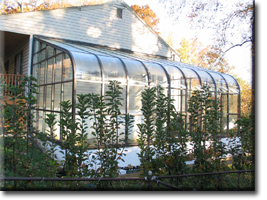
Apples
are showy with hundreds of pinkish white blossoms in spring. Pictured here are the columnar type, which only grow 2-3 feet wide, and up to 10 feet tall, if left unpruned. We love to use then for a living fence, but have also trained a few into very dense almost “shrubs” where the space doesn’t allow them to get large. In addition to the showy flowers and fragrance in the spring, the trees will also start setting fruit on average 2 years after planting. Apples are tough to grow organically though, so if you don’t want to use pesticides, you may not have much in the way of a crop. One such organic control involves spraying red plastic cups hung with an adhesive, and hanging the cups in the trees to control coddling moths. The moths are drawn to the red color and get stuck to the cups, and are therefore unable to lay their eggs on the actual smaller green apples.
Apricots
are showy with hundreds of pinkish white blossoms in spring. Self-pollinating, but for biggest crops plant Chinese as a pollinator. Apricots are truly a fruit that needs to be grown and picked locally. Sweet and delectable, when fully ripe they are just too soft to ship. Supermarket fruit looks like an apricot, but is often hard, tasteless, and disappointing. Our wet springs lead to disease problems and since they are among the first trees to bloom, they are often hurt by frost. Despite these problems, Apricots are so good that I have to take the chance.
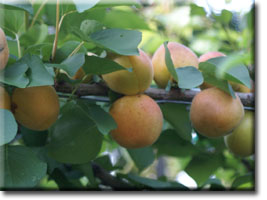
Asian Pears
are really juicy and delicious when trees ripen … their juice will literally be dripping off your hands, so it may be best to eat them outdoors! They are sometimes called apple pears because of their round shape. Asian pears have crisp, apple-like flesh. Asian Pears are one of those fruits that must be home grown to fully appreciate its sweetness and flavor. The trees sport abundant showy flowers in March and large attractive deep green foliage the remainder of the season. The fruit is typically brown or yellow when mature.
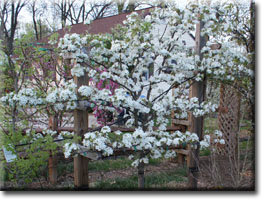

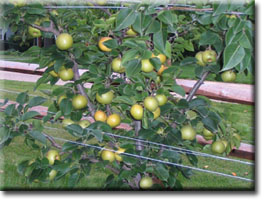
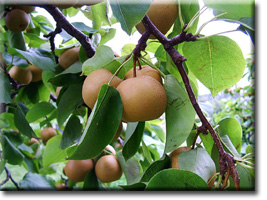
Blackberries
are perennial plants which typically bear on the canes two years old. In its first year a new stem grows to its full length arching up and usually tapering back to the ground some distance away. The stem does not produce flowers the first year. In its second year, the cane bears flowers and then fruit. Unmanaged plants form a tangle of dense stems, the branches rooting from the node tip on many species when they reach the ground. They tolerate poor soils and are seldom bothered by pests or diseases. We only stock the thornless varieties, so you don’t have to deal with the thorns when picking.
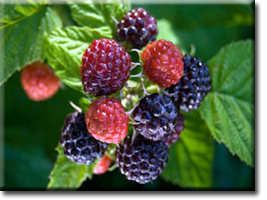
Blueberries
come in many varieties. We grow an assortment of highbush, lowbush, and hybrids between the two. Pictured below right in the background are the dormant blueberry plants right after delivery in the early spring ~ they are just starting to flower and will even bear fruit in the pots. It is great fun to go out and pick a hand full of fresh blueberries to add to your cereal or pancakes. So-called “wild” (lowbush) blueberries are smaller than cultivated highbush varieties and are prized for their intense color and sweeter flavor. There are numerous highbush cultivars of blueberries, each of which have a unique and diverse flavor and ripening time. With a mix of early, mid and late season varieties, you can have fresh blueberries for almost two months. We freeze surplus fruit and even without netting, we harvest a 4-5 gallons of berries each year from 8 lowbush plants and that again from 4 highbush plants.
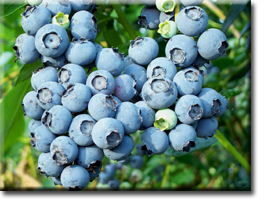

Cherries: Sour
are generally self fertile and can pollinate sweet cherries, but may not bloom at the same time ~ trees must bloom at the same time for them to cross-pollinate. Sour cherries make the best pies and jams, but you have to grow your own—markets rarely offer them. Some varieties are sweet enough to eat fresh, too. For best flavor, let them ripen on the tree, but keep them covered to prevent bird theft!
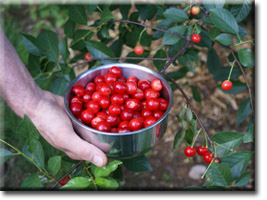
Cherries: Sweet
Is there anything like a ripe cherry picked right off the tree? They store well … if you manage to get them to the refrigerator in the first place! They can also be frozen or dried for enjoyment out of season. They are generally not self-fertile, so you will need two in your yard for cross pollination. Fruiting cherries are just as glorious in their spring bloom as the ornamental varieties, but with the fruit as a bonus, I wonder why anyone would plant the ornamentals? Most cherries are red when ripe, but we favor the yellow varieties, as they seem to be less prone to issues with the birds. Perhaps it is the lack of red coloring?
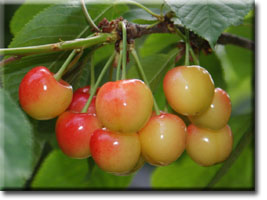

European Pears
make especially good landscape specimens with their glossy dark green foliage in addition to providing delicious fruit. Most European pears require another variety planted within 50 feet for cross-pollination. European pear fruits have the traditional pear shape—a wide bottom and narrower top. European pears have soft, melting flesh when ripe. Pears are best picked when still somewhat hard and allowed to ripen at room temperature or in the refrigerator. Fruit that over ripens on the tree develops hard, gritty spots in the flesh and may turn brown and mushy near the core.

Figs
can be grown either in pots or with winter protection if they are in an exposed location. To fully enjoy fresh figs you must grow your own. When fully ripe and at their tender best, shipping them long distances is almost impossible. Ever have a fresh fig? Let’s just say that any road weary produce you purchased from a grocery store won’t come close to fresh picked! Every summer I look forward to the start of fig season. Another plus for figs—deer don’t seem to like them.


Fuzzy Kiwi
is grown both for its ornamental value and fruit with its fast-growing vine. The flowers are white and often hidden by the foliage. The leaves are a lovely heart shape and fuzzy like the fruit, especially when they are young. There are separate male and female plants, so make sure you have both to ensure polination. This vine prefers full sun to partial shade and moist soil conditions. It is a beautiful choice for growing on trellises, arbors, fences or walls. The fruit is picked hard in late fall, and allowed to ripen indoors. The plants are extremely productive, and one mature plant will produce several bushels of fruit annually.
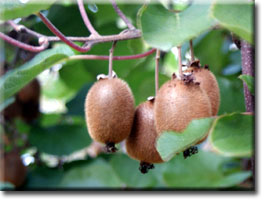

Grape Kiwi
is grown both for its ornamental value and fruit with its fast-growing vine. The flowers are white and often hidden by the foliage. The leaves are primarily green, but the male plants of one variety variegate with white and pink in the leaves. There are separate male and female plants, so make sure you have both to ensure pollination. This vine prefers full sun to partial shade and moist soil conditions. It is a beautiful choice for growing on trellises, arbors, fences or walls. The fruit is picked when it becomes soft, usually in September here in zone 7. The plants are extremely productive, and one mature plant will produce several hundred fruit annually… But they are only the size of small grapes, so don’t despair ~ we are sure you will put them all to good use!
Grapes
come in an assortment of seedless table and concord grapes, and we grow them both. The name table grapes is a bit misleading, because very few actually make it to the table! The concord grapes turn into the most amazing jelly … Pictured below right in the foreground are the dormant grape plants right after delivery in the early spring. It is amazing how fast they leaf out and grow.
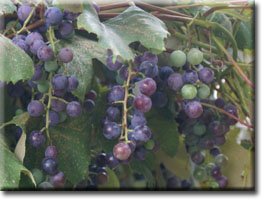
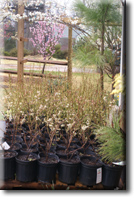
Nectarines
can be used in the same way as peaches, and may be considered as substitutes for peaches. Genetically, the only difference between peaches and nectarines is the lack of fuzz. They are usually smaller than peaches and have more red color on the surface, and more aroma. Nectarines may be either yellow or white-fleshed. As if their fruit wasn’t reason alone to grow them, the flowers are infinitely more showy than peaches and the entire tree is literally smothered in flowers in the spring. Besides eating them right off the tree, some of my favorite uses for nectarines are pies, cobbler, and shortcake. I also like to mix them with other fruit for a fruit salad.
In years without frost and freeze damage, more fruit will set than the tree can support and fruit must be thinned. Approximately three weeks after bloom or when the largest fruit are as large as a quarter, fruits should be removed by hand so that the remaining nectarines are spaced about every 8 inches. Fruit thinning will allow the remaining fruits to develop optimum size, shape, and color.

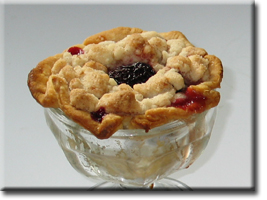
Paw Paw
fruit tastes like a mix between a banana and a mango, and they are winter hardy & native to our area. The fruit is extremely aromatic and literally perfumes the whole house. They are also extremely fragile and don’t ship well, so you will probably never see them in the supermarket. Have you ever heard of a Paw Paw?
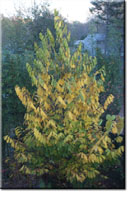



Peaches
are delicious fresh from a tree. Besides eating them right away, some of my favorite uses for peaches are pies, cobbler, and shortcake. I may also make peach jam, jelly, preserves, and mix them with other fruit for a fruit salad. There are hundreds of different peach varieties, but basically there are two types ~ the freestones and the clingstones. In freestone types, the flesh separates readily from the pit. In the clingstone type, the flesh clings tightly to the pit. The flesh may be either yellow or white. Freestone types are usually preferred for eating fresh or for freezing, while clingstone types are used primarily for canning.
In years without frost and freeze damage, more fruit will set than the tree can support and fruit must be thinned. Approximately three weeks after bloom or when the largest fruit are as large as a quarter, fruits should be removed by hand so that the remaining peaches are spaced about every 6-8 inches. Fruit thinning will allow the remaining fruits to develop optimum size, shape, and color.
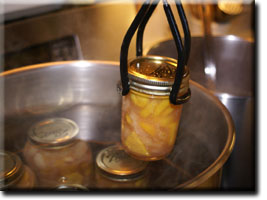
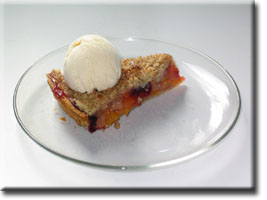

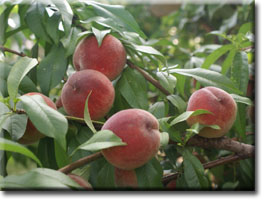
Persimmons
have dark green waxy leaves, almost tropical in appearance, that alone is a sufficient reason to grow the tree. Persimmons will also light up the fall landscape with deep yellow, orange and scarlet foliage. Their striking, large, delicious, bright orange fruits stay on the tree well after the leaves are gone. Persimmon trees are not bothered by pests or diseases.
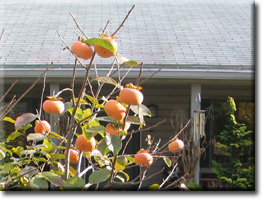

Quince
fruit when flowering is used to make a delicious and fragrant syrup that is high in vitamin C and has a strong lemony flavor. They are prized for both their fruit and ornamental value. They are very hardy shrubs, typically growing 4-6 ft. in height or less. They are early blooming and offer one of the first blooms of spring in our landscapes. The contorted variety adds the beauty of its twisted, gnarled branches to its striking white and pink blossoms. Just like forsythia, you can even bring branches of quince indoors and force them to bloom.
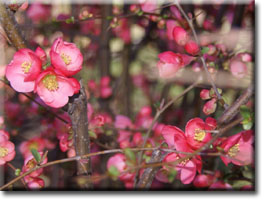
Raspberries
need ample sun and water for optimal development. While moisture is essential, wet and heavy soils or excess watering can cause root rot. Two types of most commercially grown kinds of raspberry are available, the summer-bearing type that produces an abundance of fruit on second-year canes within a relatively short period in mid-summer, and ever-bearing plants, which also bear some fruit on first-year canes in the late summer and fall, as well as the summer crop on second-year canes. Raspberries are very vigorous and can be locally invasive. They propagate using basal shoots (also known as suckers); extended underground shoots that develop roots and individual plants. They can sucker new canes some distance from the main plant. For this reason, raspberries spread well, and can take over gardens if left unchecked. Excess fruit can be made into raspberry jam or frozen.

Strawberries
were originally cultivated using straw mulch. This may have led to their name. Strawberries have a taste that varies by cultivar, and ranges from quite sweet to rather tart. Plants prefer full sun and soil that is a bit on the sandy side, and also containing ample organic matter. Strawberries are a strong plant that will survive many conditions, but when the plant is fruiting, it is especially important for it to get ample water. Strawberries can be grown as a potted plant and while they will still produce fruit, the quantity of fruit will be significantly reduced compared to direct planting in the ground. In Falls Church, they start blooming the first week of April and we are picking them by the first of May. Very few of our Strawberries actually make it into the house, but any excess fruit can be made into jam, frozen or dried.

